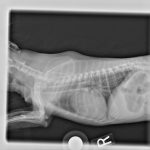Intratracheal Stents for Pets
 Unfortunately the diagnosis of a collapsing trachea is one all too many pet owners are familiar with. Small breed dogs, especially Toy Poodles, Pomeranians, Yorkshire Terriers, Chihuahuas, Maltese, and Pugs are predisposed to this condition. Many times pet owners learn to live with this problem and manage it medically, however some pets may need more aggressive treatment. We are happy to be able to offer tracheal stenting to these patients.
Unfortunately the diagnosis of a collapsing trachea is one all too many pet owners are familiar with. Small breed dogs, especially Toy Poodles, Pomeranians, Yorkshire Terriers, Chihuahuas, Maltese, and Pugs are predisposed to this condition. Many times pet owners learn to live with this problem and manage it medically, however some pets may need more aggressive treatment. We are happy to be able to offer tracheal stenting to these patients.
What Is Tracheal Collapse?
For some pets, breathing isn’t easy. The trachea, also known as the windpipe, connects the airway to the lungs. Normally it is a rigid tube made up of rings of cartilage that extend from the back of the throat, through the neck, and into the thorax.
Sometimes the rings that make up the trachea become weak, allowing the windpipe to collapse on itself. This creates irritation and even blockage of the airway, resulting in coughing, and if things are bad enough, respiratory distress.
Pets with tracheal collapse tend to have the most problems when they need to breathe rapidly, such as when they are anxious or excited. Many times dogs with this problem do not show signs of an issue until another problem compounds the issue. These can include:
- Weight gain
- An anesthetic event
- An upper respiratory problem such as kennel cough
- Exposure to irritants such as cigarette smoke
- Development of heart enlargement
What is Intraluminal Tracheal Stenting?
Most pets can be successfully managed for tracheal collapse with medical treatment. Underlying problems such as obesity or exposure to airborne allergens are addressed. Sometimes medications such as cough suppressants, corticosteroids, or airway dilators are prescribed.
A small percentage of pets with tracheal collapse experience severe enough symptoms that surgery may be required. These pets are candidates to have an intratracheal stent placed.
An intratracheal stent is a self-expanding prosthesis that is placed in the affected portion of the airway, expanding the trachea and preventing collapse of the windpipe in the patient. Until recently, stents were only able to be placed on the outside of the trachea, making patients with collapses within the thoracic cavity unable to have the procedure performed.
What is Involved With Tracheal Stenting?
Intratracheal stenting is a minimally invasive procedure performed under a short-term anesthesia. By placing the stent inside of the trachea, many of the more common complications that were seen with extraluminal stenting are avoided.
Post-operatively, pets still need to be managed medically, however intratracheal stents can dramatically improve respiratory function in affected pets. In fact, 75-90% of dogs having the procedure performed experience improvement in their clinical signs.
Oakland Veterinary Referral Services is excited to be able to offer intratracheal stenting to our patients. Dr. Jennifer Clooten, who has recently joined our internal medicine team, is experienced in placing these stents and looks forward to helping many pets suffering from severe tracheal collapse.
If you have questions about intraluminal tracheal stenting or would like to discuss whether your pet may be a candidate for the procedure, please do not hesitate to contact us. We look forward to helping you.


